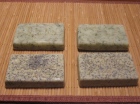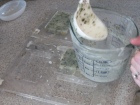The Local newsletter is your free, daily guide to life in Colorado. For locals, by locals.
Ever since I made my own laundry detergent, I’ve been wanting to make my own homemade soap–especially after I found out I could use my herb garden to scent it.
 I contacted Jennifer Mason, a local crafter and seamstress who runs hip-threads.com, and asked her if she would walk me through the steps. She has been making (and selling) homemade soaps for three years and has crafted hundreds of different bars. She was kind enough to slow down the process for those of us looking to get started.
I contacted Jennifer Mason, a local crafter and seamstress who runs hip-threads.com, and asked her if she would walk me through the steps. She has been making (and selling) homemade soaps for three years and has crafted hundreds of different bars. She was kind enough to slow down the process for those of us looking to get started.

Before you begin, you’ll need to buy a couple things. Pick up some glycerin (see step 1), some plastic molds (available at craft stores), and keep a measuring cup nearby. Other than that, grab yourself a glass of wine, and you’re set.
Step 1: Purchase glycerin.
Most one- and five-pound blocks of glycerin can be found at many craft stores, such as Jo-Ann and Michael’s. If you’re looking to make hand soap for the kitchen or bathroom, Mason recommends the clear, olive oil glycerin. Look for the phrase “suspending soap.”

“Suspending soap helps all the ingredients not fall to the bottom,” she says. If you’re wanting to make a soap for the shower, Mason suggests using the shea butter glycerin, which is more soft and creamy for the body. These run $24.99 for five pounds, which she says will yield enough soap for a year.
Bonus tip: If you sign up for e-mail coupons at Jo-Ann, you’ll regularly get 50 percent-off coupons to cut your soap-making costs in half.
Step 2: Nuke the glycerin.
 Your soap will be made up of small squares, much like a chocolate bar. Carve out six to eight of the smaller squares and toss them into a measuring cup: This amount makes two to three bars of soap. Use a lesser power on the microwave (think level six or seven) and put it in for two minutes.
Your soap will be made up of small squares, much like a chocolate bar. Carve out six to eight of the smaller squares and toss them into a measuring cup: This amount makes two to three bars of soap. Use a lesser power on the microwave (think level six or seven) and put it in for two minutes.
Bonus tip: Mason recommends watching the glycerin to make sure it doesn’t get too hot–otherwise it will melt your mold. Let it cool off if it’s boiling or steaming. If you dip your finger in the mixture, it should feel like a hot coffee that is still comfortable for you to drink. Mason watches for the glycerin to build a slight skin, not unlike the film that can form on the top of hot chocolate as it cools.
Step 3: Mix in the herbs.
While the glycerin is nearing the right temperature, it’s time to add the nice smells. 
If you want to make hand soap, grab basil, parsley, and oregano, which are naturally anti-bacterial. Mason recommends starting with around a half a tablespoon of each, and stirring. For the body soap, she adds scents like peppermint, lavender, and vanilla. (Just add a drop or two of the extracts.)
Bonus tip: If you don’t have a lot of herbs, raid your tea bags. Mason says green teas and chamomile can work great for bath soap, and spice and zinger teas are good for hands. Cut open two bags and dump the contents into your melted glycerin.
Step 4: Pour it in the molds. 
Ladle the glycerin and herb mixture into the molds.
Bonus tip: Mason buys her reusable molds, which have room for three or four soaps, but she says to look around your home for inspiration. “Kids toys can be good shapes, or use old soap dishes,” she says.
Step 5: Let the soap set.
 Either let your soap set out on the counter for 30 minutes, or put it in the freezer, which is what Mason does. Freezing the soap cuts the setting time nearly in half and helps the soap pop out of the molds a bit easier. Once your soap is set, turn it upside down, and use consistent, gentle pressure to pop it out of the mold.
Either let your soap set out on the counter for 30 minutes, or put it in the freezer, which is what Mason does. Freezing the soap cuts the setting time nearly in half and helps the soap pop out of the molds a bit easier. Once your soap is set, turn it upside down, and use consistent, gentle pressure to pop it out of the mold.
Bonus tip: You may want to immediately throw your new soap in the soap dishes around your house, but if you have extras, simply store them away in saran wrap. Mason also recommends using your leftovers as a gift.








